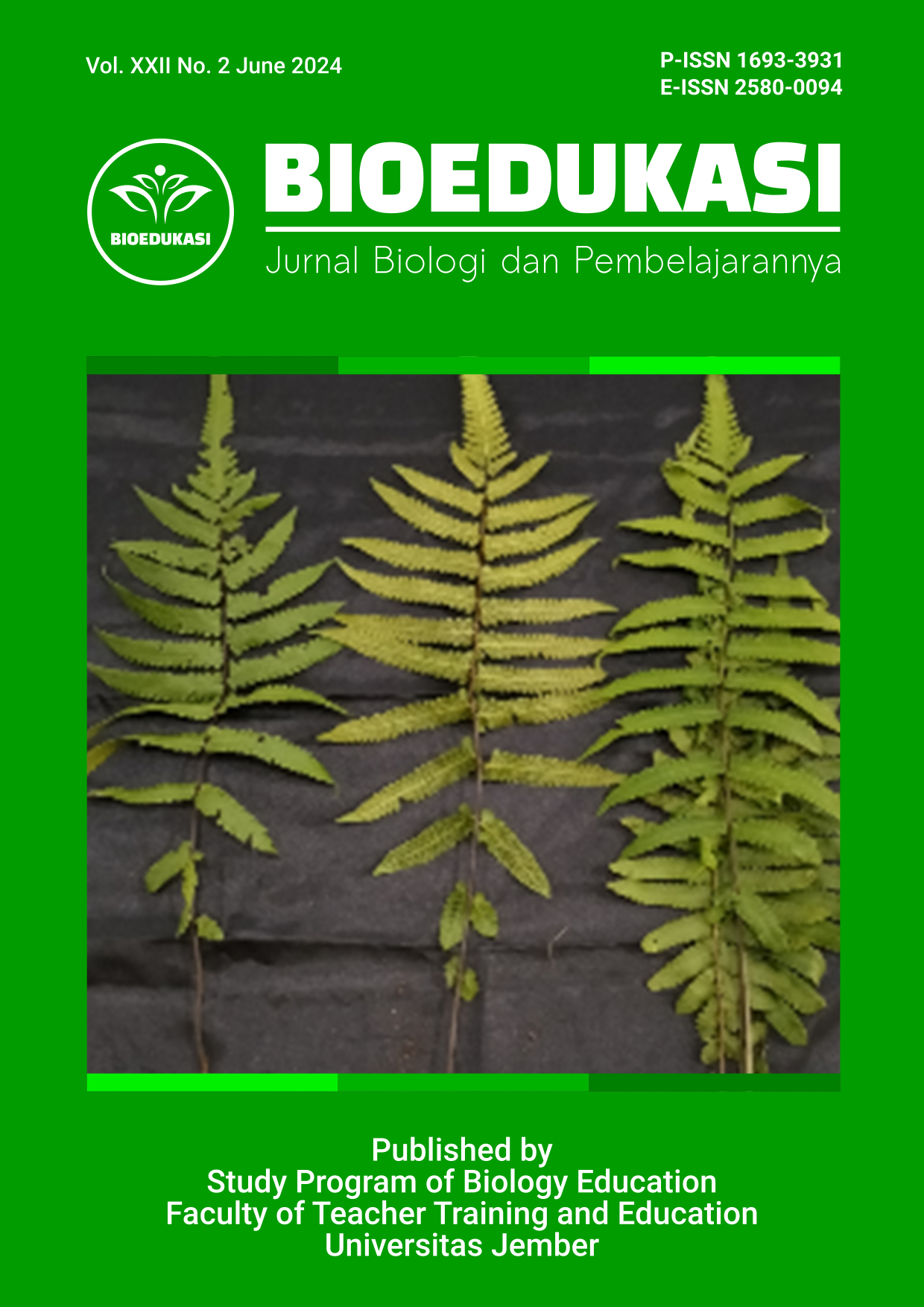Molecular identification of Cyclosorus parasiticus (L.) Farw. From Gumitir, Jember Indonesia
DOI:
https://doi.org/10.19184/bioedu.v22i2.45484Keywords:
Cyclosorus parasiticus, DNA Barcode, Ferns, rbcLAbstract
Cyclosorus parasiticus (L.) Farw. from Mount Gumitir dominates the understory ferns vegetation along the roadside of a pine-mixed coffee plantation. Previous studies reported the metabolite profile with the flavonoid and alkaloid content. Current observations based on morphological structure of the specimens collection indicated a high variations, therefor molecular identification was required to support the phylogenetic data of the species. The aim of the study was to identify the Cyclosorus parasiticus sample originate from Gumitir using DNA barcode. We used three primers, i.e. ribulose 1,5-biphosphate carboxylase (rbcL), maturase K (matK), and Internal transcribed spacer 2 (ITS2) for molecular identification. The result showed that Cyclosorus parasiticus from Gumitir has a highest similarity with Christella latipinna (NC070300) from China with a value of Percent Identities value of 99.11% based on the ITS2 marker. The rbcL data in this study might contribute to supporting the molecular genus concept from recent Thelypteridaceae phylogeny.
Downloads
References
CBOL. (2009). A DNA barcode for land plants. Supporting Information. Proceedings of the National Academy of Sciences of the United States of America, 106(31), 12794–12797. http://www.pubmedcentral.nih.gov/articlerender.fcgi?artid=2722355&tool=pmcentrez&rendertype=abstract
Fawcett, S., & Smith, A. R. (2021). A generic classification of the Thelypteridaceae. BRIT Press.
Fawcett, S., Smith, A. R., Sundue, M., Burleigh, J. G., Sessa, E. B., Kuo, L.-Y., Chen, C.-W., Testo, W. L., Kessler, M., Consortium, G., & Barrington, D. S. (2022). A Global Phylogenomic Study of the Thelypteridaceae. Systematic Botany, 46(4), 891–915. https://doi.org/10.1600/036364421x16370109698650
Fraser-Jenkins, C. R., Smith, A. R., Jarvis, C. E., Gibby, M., Price, M. G., Parris, B. S., & Kholia, B. S. (2018). (2640) Proposal to conserve the name Polypodium parasiticum (Thelypteris parasitica, Christella parasitica) (Thelypteridaceae) with a conserved type. Taxon, 67(5), 1031–1032. https://doi.org/10.12705/675.16
Holttum, R. E. (1980). The Fern-Family of Thelypteridaceae in Malaya. In The Gardens’ bulletin, Singapore (Vol. 33). Singapore, Govt. Print. Off. [etc.].
Ida, H., Atik, R., Rugayah, Dewi, S., Florentina Indah, Wi., Wita, W., Himmah, R., & Deby, A. (2019). Status Keanekaragaman Hayati Indonesia (Kekayaan Jenis Tumbuhan dan Jamur Indonesia). LIPI Press. http://lipi.go.id/publikasi/status-keanekaragaman-hayati-indonesia-kekayaan-jenis-tumbuhan-dan-jamur-indonesia/32247
Kusumaningsih, P., U. Dhyana, dan P. Bali. 2021. Analisis filogenetik bakteri serratia sp. dan kurthia sp. pada pindang tongkol (euthynnus affinis). Seminar Nasional Bioteknologi. 1(1):64–69.
Lin Y, Hu F, Tang J, Moret BM. (2013). Maximum likelihood phylogenetic reconstruction from high-resolution whole-genome data and a tree of 68 eukaryotes. Pac Symp Biocomput.:285-96. PMID: 23424133; PMCID: PMC3712796.
Makhmud, M. (2018). Inventarisasi Tumbuhan Paku (Pteridophyta) Berpotensi Obat Di Hutan Pinus Desa Garahan Kecamatan Silo Kabupaten Jember. Universitas Jember.
Maskun, Assidiq, H., Mukarramah, N. H. Al, & Bachril, S. N. (2021). Threats to the sustainability of biodiversity in Indonesia by the utilization of forest areas for national strategic projects: A normative review. IOP Conference Series: Earth and Environmental Science, 886(1). https://doi.org/10.1088/1755-1315/886/1/012071
Nitta, J.H. and Chambers, S.M., 2022. Identifying cryptic fern gametophytes using DNA barcoding: A review. Applications in Plant Sciences, 10(2), p.e11465.
Powo. (2023). Plant of the World Online : Thelypteris parasitica. https://powo.science.kew.org/taxon/urn:lsid:ipni.org:names:1160951-2#publications
Prasani, A., Puspita, L., & Putra, E. P. (2021). Tumbuhan Paku (Pteridophyta) Di Area Kampus Universitas Islam Negeri Fatmawati Sukarno Bengkulu. Jurnal Biosilampari: Jurnal Biologi, 4(1), 7–12. https://doi.org/10.31540/biosilampari.v4i1.1347
Setiawan, A. (2022). Keanekaragaman Hayati Indonesia: Masalah dan Upaya Konservasinya. Indonesian Journal of Conservation, 11(1), 13–21. https://doi.org/10.15294/ijc.v11i1.34532
Setyati, D., Sulistiyowati, H., Erizcy, M. P., & Ratnasari, T. (2020). The Flavonoid and Alkaloid Content of Cyclosorus parasiticus (Linn.) Farwell Ferns At the Plantation Areas of Jember Regency. BIOLINK (Jurnal Biologi Lingkungan Industri Kesehatan), 7(1), 23–37. https://doi.org/10.31289/biolink.v7i1.3026
Setyati, D., Sulistyowati, H., Rahmawati, R., & Ratnasari, T. (2021). The spores structure of ferns growing in mountain Gumitir coffee plantation area Jember Regency. IOP Conference Series: Earth and Environmental Science, 743(1). https://doi.org/10.1088/1755-1315/743/1/012089
Setyati, D., Adawiyah, R., Ratnasari, T., Su'udi, M., & Ulum, F.B (2023). Phenolic Profile and Antimicrobe of the Asplenium nidus L. from Mount Gumitir, Jember, East Java, Indonesia. BIOEDUKASI, 189-193. doi:10.19184/bioedu.v21i3.43368
Su’udi, M. and Setyati, D., (2022), December. DNA Barcoding of Vanda tricolor Lindl. Based on matK, rbcL and ITS2 Sequences. In 4th International Conference on Life Sciences and Biotechnology (ICOLIB 2021) (pp. 596-604). Atlantis Press. https://doi.org/10.2991/978-94-6463-062-6_61
Su’udi, M., Setyati, d., Khoirunnisa, g. A., Afidah, Y., Ulum, F.B., (2023). The matK Mini-barcode as a Potential Molecular Identification Tool for Medicinal Orchids. Life Science and Biotechnology, 1(1), pp.21-26.
Trujillo, S., del Castillo, R. F., Tejero-Diez, D., Matias-Cervantes, C. A., & Velasco-MurguÃa, A. (2021). DNA barcoding ferns in an unexplored tropical montane cloud forest area of southeast Oaxaca, Mexico. Scientific Reports, 11(1), 1–12. https://doi.org/10.1038/s41598-021-02237-8
Ulum, F.B., Setyati, D. and Su'udi, M., 2023. Epiphytic ferns and orchids adaptation mechanism based on stomatal structure and chlorophyll content in Urban Forest of Jember University, Indonesia. Life Science and Biotechnology, 1(1), pp.10-15.
Ulum, F.B., Setyati, D., Rizqoni, M.I.A. and Su'udi, M., (2023) Antimicrobial and Phytochemistry study of Liparis resupinata Ridl. from Mount Gumitir, East Java, Indonesia. JPSCR: Journal of Pharmaceutical Science and Clinical Research, 8(3), pp.373-384. http://dx.doi.org/10.20961/jpscr.v8i3.70856.




 https://orcid.org/0000-0003-1920-0515
https://orcid.org/0000-0003-1920-0515